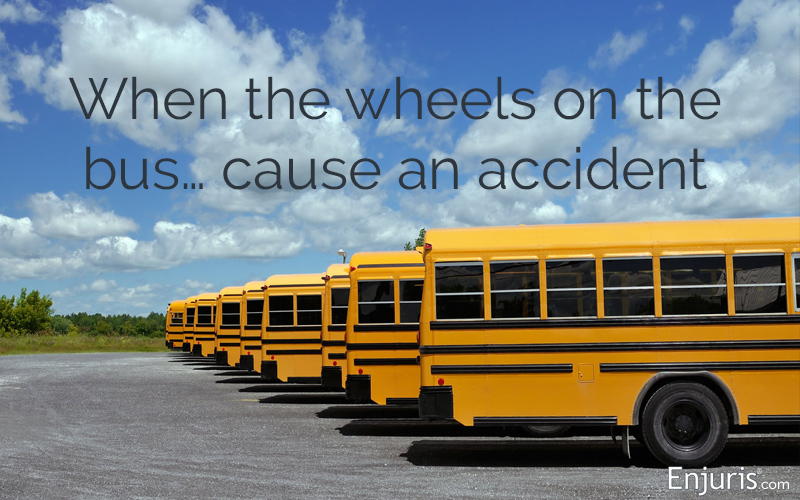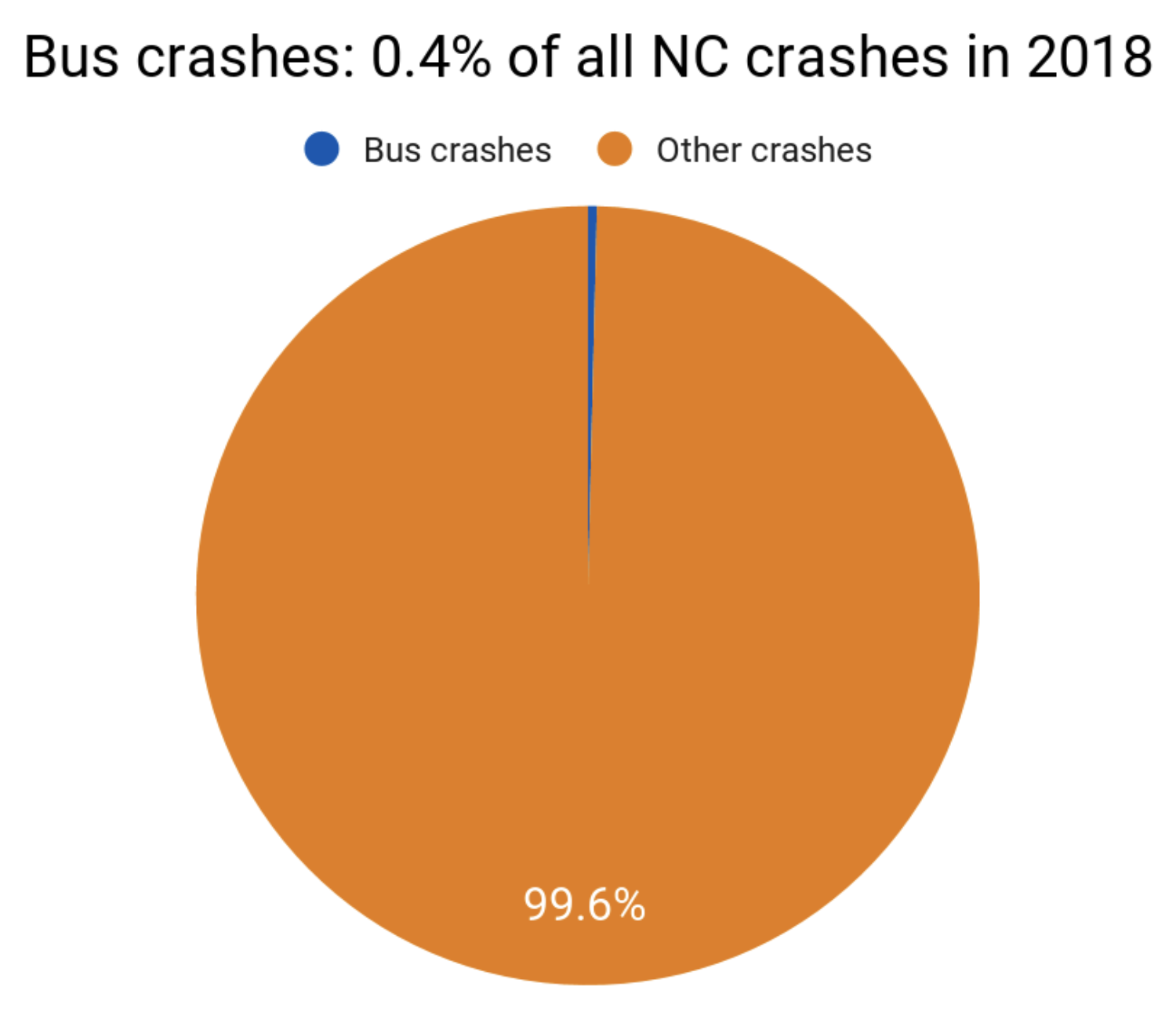
A guide to bus crash compensation in the Tarheel State
On January 7, 2020, a tractor-trailer hit a stopped school bus on Route 74/76 in Columbus County, North Carolina. The truck driver had dropped a cigarette and bent down to retrieve it while driving, so he didn’t see the stopped bus in time. A FedEx truck traveling behind the 18-wheeler also hit the school bus. The bus rolled 3 times before coming to a standstill in a ditch alongside the road.
There were 8 children and 2 adults on the bus at the time of the accident, and 2 of those children were taken to a Wilmington trauma center with serious injuries.
Accidents like this aren’t common, but they do happen. And when they do, it can be especially catastrophic and traumatic for the people involved.
North Carolina bus accident statistics
The National Highway Traffic Safety Administration (NHTSA) crash statistics show that North Carolina had 0 bus occupant fatalities in 2014, 2015, 2017, or 2018. There were 4 in 2016.
Still, you can be injured either as a bus occupant or while driving your own car in a collision with a bus. The North Carolina Department of Transportation released the following data on bus crashes as compared to other vehicle crashes:
| Crash type (in 2018) | All crashes | Fatal crashes | Injury crashes |
|---|---|---|---|
| Commercial bus | 577 | 3 | 192 |
| School bus | 1,014 | 5 | 261 |
| Activity bus | 133 | 0 | 44 |
| Other bus | 164 | 1 | 51 |
| Totals (all vehicles) | 510,970 | 2,388 | 153,394 |
Based on this information, bus crashes make up only a very small portion of the total crashes in North Carolina.

But it’s important to remember that every statistic represents a person who was involved in a crash. That’s why, even though buses are relatively safe, you still need to know what to do if you’re injured in a North Carolina bus accident.
Bus transportation in North Carolina
Greyhound offers 7 fixed intercity routes in North Carolina. The NCDOT partners with Greyhound Lines Inc. and Sunway Charters to provide busing as an alternative to driving between major cities. These routes receive federal, state and local funding, and they offer transportation between urban and rural areas.
North Carolina has the following intercity routes:
- Raleigh to Norfolk, VA via Rocky Mount and Ahoskie
- Raleigh to Norfolk, VA via Rocky Mount, Wilson, Greenville, Washington, Edenton and Elizabeth City
- Raleigh to Wilmington via Smithfield, Goldsboro and Wallace
- Raleigh, Wilmington, Jacksonville
- Jacksonville, Wilmington, Myrtle Beach
- Mountaineer East/West; Greensboro to Boone via Winston-Salem Transit Center, Baptist Hospital, Forsyth Hospital, Asbury Church Park-and-Ride and Wilkesboro
- Mountaineer North/South; Boone to Charlotte via Lenoir, Newton, Lincolnton and Gastonia
Commuting by bus in North Carolina
North Carolina owns nearly 14,000 public school buses, maintains 80 community transit systems, and is home to more than 20 urban transit systems.
From GoTriangle to Tar River Transit and many others along the way, about 104,000 of the 10.4 million residents of North Carolina use public transportation to get to work.
NCDOT BOSS System
“BOSS” stands for “Bus on Shoulder System” in North Carolina.
In an attempt to maintain bus schedules and decrease congestion, the NC Department of Transportation allows buses to travel on the shoulders of designated interstates and other roadways.
If a bus is traveling on the shoulder, it must:
- Travel at no more than 15 miles per hour faster than the speed of traffic, and no more than 35 miles per hour total.
- A bus on the shoulder must yield to an emergency vehicle or any vehicle that’s parked on the shoulder.
- The bus driver must use discretion to determine if traveling on the shoulder is safe.
Common causes of North Carolina bus accidents
Vehicle collisions have many of the same causes, whether it’s a crash between passenger cars, a truck accident, or a bus accident.
- Driver distraction or fatigue.
- Vehicle equipment defects
- Location difficulties (little room to maneuver, especially in heavily populated or urban areas)
- Bad road conditions and poor weather
- Weight distribution problems (tipping hazard)
- Lack of proper driver training
A tip-over or rollover is more likely for a bus than a passenger car because of the height and distribution of weight within the vehicle. Adding to this risk is that most bus passengers don’t wear seatbelts and buses aren’t usually equipped with airbags.
That means that even though bus accidents aren’t as common as car accidents, injuries are often more serious when a bus crashes.
There are 4 ways to be injured in a bus accident:
- As a bus occupant (passenger or driver)
- As a rider when you’re boarding or leaving the bus
- As a pedestrian or bicyclist who’s hit by a bus
- As a motorist involved in a collision with a bus
Negligence and damages in a North Carolina bus accident
These are 4 important elements of any personal injury claim that bus accident victims should understand:
- A person or entity owes a duty to another person. (You don’t need to know someone personally or have a relationship with them in order to have a duty of care — any driver on the road owes a duty to other road users to avoid any behavior that could cause harm. A bus driver owes a duty to riders, pedestrians, other motorists, and anyone else who could potentially suffer harm from a bus accident.)
- The defendant’s action or inaction negligently breaches their duty of care to the plaintiff.
- The plaintiff is injured by the defendant’s negligence.
- The injury costs the plaintiff money.
One reason why buses are considered a safer form of transportation is that the size of the bus and certain safety measures usually mean that most minor bus collisions don’t result in any injuries, at all. You might feel afraid, shaken up, or angry if you were a passenger on a bus that was in a minor accident. After all, you rely on public transportation to be safe and maybe to save you the stress of driving yourself.
But those feelings don’t necessarily mean you can claim damages.
You can only claim damages in a North Carolina bus accident (or for any personal injury) if your injuries included a financial cost.
You can bring a claim for damages to cover costs that include:
- Medical care, including surgeries, doctor or hospital visits, medications, etc.
- Ongoing treatment like physical or occupational therapy
- Lost wages for time off from work as a result of your injuries. This also includes loss of future earning capacity if you become disabled or your injuries prevent you from returning to your current job.
- Property repair or replacement.
- Wrongful death if the accident resulted in the death of a family member.
- Pain and suffering or other emotional distress.
In some circumstances, you can include a claim for punitive damages. Punitive damages are a punishment issued by the court against a defendant who acted in an especially malicious or reckless way. It’s often a way to deter the defendant or others from behaving that way in the future.
How to prove fault (liability) for a North Carolina bus accident
The first aspect of a personal injury claim is establishing who’s liable.
This step can be particularly tricky in a bus accident. If the driver caused the collision, liability might still rest on the bus company as their employer. If the accident is from an equipment malfunction, liability could be on the manufacturer of the bus or one of its parts. If the bus is involved in an accident with a car, it’s possible that driver is at fault.
As a bus passenger, you might not know right away who is the liable party. After all, for many people who travel by bus, they’re using that time to read, sleep, work, or otherwise relax. You’re likely not paying attention to the traffic when you’re a bus passenger, so you probably have no idea how an accident happened.
A North Carolina personal injury lawyer can use the legal discovery process, along with evidence from the scene and related documents, to determine who’s liable for the accident.
Filing a claim against a government agency
The North Carolina Tort Claims Act (NCTCA) allows citizens to sue the state if an officer, employee, or agent negligently causes harm while acting within the scope of their duties. In other words, if you were injured in a North Carolina bus accident involving a bus owned by a municipal authority, you might be able to sue the North Carolina Department of Transportation just as you would if it were a private entity.
The driver is ultimately responsible for operating a bus safely.
If the bus belongs to a private company, you might be able to make a claim against the company for the driver’s negligence. The vicarious liability doctrine says that an employer can be held liable for the action of an employee.
If the bus belongs to a government agency or municipality, you might be up against sovereign immunity. That means you can’t sue the government for its employee’s negligent act. If that happens, you might need to file a claim with the North Carolina Industrial Commission in order for the government to waive its sovereign immunity.
It’s possible to bring a successful claim against a government entity, but you’ll need an experienced North Carolina lawyer who’s familiar with the laws and strategies for doing so.
School bus accidents
The Transportation Research Board (TRB) says the school bus is the safest way for students to travel back and forth to school.
“Students are about 70 times more likely to get to school safely when taking a school bus instead of traveling by car.”
In fact, the most dangerous part of the school day “commute” is a student getting to and from the bus stop, and getting on and off the bus.
A school bus is designed with safety features that make them safer than a passenger car. For example, protective seats, high crush standards, rollover protection features, and high visibility can prevent a student from being injured in the event of a crash.
In addition, the School Bus Stop Law in North Carolina requires all vehicles in both directions to stop in order to let students cross when a school bus comes to a halt and its red light stop arm is out. The only exceptions are if the bus stops on a divided highway with a median or if there’s a 4-lane highway with a center turning lane. In those instances, only the traffic traveling the same direction as the bus must stop.
What to do after a North Carolina bus accident
If you’re involved in a bus accident, the first priority is to call first responders who will provide medical treatment to anyone who’s injured, including yourself.
In a regular car or truck accident, you should try to gather evidence at the scene where possible — for example, other drivers’ contact information, witnesses, etc. A bus accident might be different, though, especially if there are a lot of people involved. It’s often best to let first responders and police do their jobs and process the scene. Witness information and other evidence can be gathered from the police reports later.
If you have suffered injuries from a North Carolina bus accident, you want to consult with a personal injury lawyer. Your lawyer will advise you of your legal options for securing a full financial recovery.
See our guide Choosing a personal injury attorney.
